The Power of Live Stream Commerce: A Case Study of How Live Stream Commerce Can Be Utilised in the Traditional British Retailing Sector
Abstract
:1. Introduction
2. Related Work
2.1. The Influence of Technology on Day-to-Day Life
2.2. The Term ‘Live Streaming’ in Context
2.3. ‘Live Stream Commerce’ Defined
2.4. User Behaviour in e-Commerce
2.4.1. Customer Satisfaction in Online Commerce
2.4.2. How Customer or User Satisfaction Is Met through Live Stream Commerce
2.5. Core Usability Principles within Live Streaming
2.6. The Dynamics of Open Innovation in Retail Commerce
2.7. The Ethics and Social Aspects of Technology
3. Methodology
3.1. Quantitative Research Methods
3.2. Qualitative Research Methods
3.2.1. Participatory Design
3.2.2. Co-Design
3.3. Mixed Research Methods and Adopted Methods
4. Design Study and Data Analysis
4.1. Method
4.1.1. Questionnaire
4.1.2. Co-Design Workshop
4.1.3. Participatory Design Workshop
4.1.4. Workshops: Through a Double Diamond Design Approach
4.2. Recruitment
4.3. Data Analysis
4.4. Questionnaire Findings
4.5. Workshop Findings
4.5.1. Participatory Design Workshop
4.5.2. PD Workshop Findings: Discover, Explore and Define
- ‘As a plug-in to existing retail platforms to provide a more detailed and diverse presentation of products and customer journeys, while also supporting smaller retailers in becoming more flexible in their business’.
- 2.
- ‘To increase accessibility and inclusivity of retail shopping from a disability, psychological, and preference point of view’
- 3.
- ‘Facilitating sustainability’
4.5.3. Co-Design Workshop
4.5.4. Co-Design Workshop Findings: Develop and Deliver
5. Discussion and Recommendations
5.1. Interaction and Engagement in Live Stream Commerce Technology
5.2. Integrated Innovation: How Live Stream Commerce Can Enhance Business Sustainability
5.3. Design Strategies and Suggestions in the Development of a Live Stream Commerce ‘Plug-in’
5.4. Live Stream Commerce as an Open Business Model
6. Conclusions
6.1. Live Stream Commerce and Open Innovation
6.2. Ethics and Limitations
Author Contributions
Funding
Institutional Review Board Statement
Informed Consent Statement
Data Availability Statement
Conflicts of Interest
References
- Foroudi, P.; Gupta, S.; Sivarajah, U.; Broderick, A. Investigating the effects of smart technology on customer dynamics and customer experience. Comput. Hum. Behav. 2017, 80, 271–282. [Google Scholar] [CrossRef]
- Lu, Z.; Xia, H.; Heo, S.; Wigdor, D. You Watch, You Give, and You Engage. In Proceedings of the 2018 CHI Conference on Human Factors in Computing Systems, Montreal, QC, Canada, 21–26 April 2018; pp. 1–13. [Google Scholar]
- Tang, J.; Venolia, G.; Inkpen, K. Meerkat and Periscope. In Proceedings of the 2016 CHI Conference on Human Factors in Computing Systems, San Jose, CA, USA, 7–12 May 2016. [Google Scholar] [CrossRef]
- Haimson, O.; Tang, J. What Makes Live Events Engaging on Facebook Live, Periscope, and Snapchat. In Proceedings of the 2017 CHI Conference on Human Factors in Computing Systems, Denver, CO, USA, 6–11 May 2017. [Google Scholar] [CrossRef]
- Wang, Y.; Lu, Z.; Cao, P.; Chu, J.; Wang, H.; Wattenhofer, R. How Live Streaming Changes Shopping Decisions in E-commerce: A Study of Live Streaming Commerce. SSRN Electron. J. 2021, 1–25. Available online: https://papers.ssrn.com/sol3/papers.cfm?abstract_id=3874121# (accessed on 5 September 2021). [CrossRef]
- McKinsey & Company. It’s Showtime! How Live Commerce Is Transforming the Shopping Experience. 2021. Available online: https://www.mckinsey.com/business-functions/mckinsey-digital/our-insights/its-showtime-how-live-commerce-is-transforming-the-shopping-experience (accessed on 5 September 2021).
- George, M. Livestream Shopping Is the Next Big Thing in Retail. Fortune. 2020. Available online: https://fortune.com/2021/01/07/livestream-video-shopping-hsn-qvc/ (accessed on 5 September 2021).
- Sun, Y.; Shao, X.; Li, X.; Guo, Y.; Nie, K. How live streaming influences purchase intentions in social commerce: An IT affordance perspective. Electron. Commer. Res. Appl. 2019, 37, 100886. [Google Scholar] [CrossRef]
- Liu, X.; Yuan, Y.; He, J.; Li, Z. Framing the Travel Livestreaming in China: A New Star Rising under the COVID-19. Curr. Issues Tour. 2022, 1–20. [Google Scholar] [CrossRef]
- Grafton-Clarke, C.; Uraiby, H.; Abraham, S.; Kirtley, J.; Xu, G.; McCarthy, M. Live Streaming To Sustain Clinical Learning. Clin. Teach. 2022. [Google Scholar] [CrossRef]
- Chen, S.; Lamberti, L. Multichannel marketing: The operational construct and firms’ motivation to adopt. J. Strateg. Mark. 2016, 24, 594–616. [Google Scholar] [CrossRef]
- Merritt, K.; Zhao, S. An Investigation of What Factors Determine the Way in Which Customer Satisfaction Is Increased through Omni-Channel Marketing in Retail. Adm. Sci. 2020, 10, 85. [Google Scholar] [CrossRef]
- Office for National Statistics. Internet Users, UK: 2020. Available online: https://www.ons.gov.uk/businessindustryandtrade/itandinternetindustry/bulletins/internetusers/2020 (accessed on 5 September 2021).
- Roggeveen, A.; Sethuraman, R. How the COVID-19 Pandemic May Change the World of Retailing. J. Retail. 2020, 96, 169–171. [Google Scholar] [CrossRef]
- Hoehe, M.; Thibaut, F. Going digital: How technology use may influence human brains and behaviour. Dialogues Clin. Neurosci. 2020, 22, 93–97. [Google Scholar] [CrossRef]
- Dodgson, M.; Gann, D.; Salter, A. The Role of Technology in the Shift towards Open Innovation: The Case of Procter & Gamble. R D Manag. 2006, 36, 333–346. [Google Scholar]
- Schepis, D.; Purchase, S.; Butler, B. Facilitating Open Innovation Processes through Network Orchestration Mechanisms. Ind. Mark. Manag. 2021, 93, 270–280. [Google Scholar] [CrossRef]
- Bereznoy, A.; Meissner, D.; Scuotto, V. The Intertwining of Knowledge Sharing and Creation in the Digital Platform Based Ecosystem. A Conceptual Study on the Lens of the Open Innovation Approach. J. Knowl. Manag. 2021, 25, 2022–2042. [Google Scholar] [CrossRef]
- Bialik, Kristen, and Richard Fry. How Millennials Compare with Prior Generations. 2019. Available online: https://www.pewsocialtrends.org/essay/millennial-life-how-young-adulthood-today-compares-with-prior-generations/ (accessed on 4 August 2019).
- Statista. How Many Hours in a Typical Week Would You Say You Use the Internet? 2021. Available online: https://www.statista.com/statistics/300201/hours-of-internet-use-per-week-per-person-in-the-uk/ (accessed on 12 September 2021).
- Li, C.; Mirosa, M.; Bremer, P. Review of Online Food Delivery Platforms and their Impacts on Sustainability. Sustainability 2020, 12, 5528. [Google Scholar] [CrossRef]
- Wood, Z. Online Shopping Makes Many High Street Jobs Unviable, Says Next Boss. The Guardian. 2020. Available online: https://www.theguardian.com/business/2020/sep/25/online-shopping-makes-many-high-street-jobs-unviable-say-next-boss (accessed on 30 September 2021).
- Statista. Number of Daily Active Users (DAU) of Microsoft Teams Worldwide as of April 2021. Available online: https://www.statista.com/statistics/1033742/world-wide-microsoft-teams-daily-and-monthly-users/ (accessed on 11 September 2021).
- Bloomberg. The Hybrid Work Revolution Is Already Transforming Economies. 2021. Available online: https://www.bloomberg.com/news/features/2021-08-26/will-remote-work-become-the-norm-hybrid-offices-are-transforming-economies (accessed on 23 September 2021).
- Zimmer, F. A Content Analysis of Social Live Streaming Services. In Social Computing and Social Media; User Experience and Behavior. Lecture Notes in Computer Science; Springer: Cham, Germany, 2018; Volume 10913, pp. 400–414. Available online: https://www.researchgate.net/publication/325460357_A_Content_Analysis_of_Social_Live_Streaming_Services (accessed on 31 October 2021).
- Statista. Total Hours Watched Across Leading Live Streaming Platforms as of 4th Quarter 2020 (In Billions). 2021. Available online: https://www.statista.com/statistics/1264246/quarterly-live-streaming-hours-watched/ (accessed on 11 September 2021).
- Larson, K. Retailers Embrace Livestreaming, Market Expected to Reach $11 Billion in 2021. Forbes. Available online: https://www.forbes.com/sites/kristinlarson/2021/03/27/retailers-embrace-livestreaming-market-expected-to-reach-11-billion-in-2021/?sh=6b8d5be22fde (accessed on 30 September 2021).
- Li, Y.; Wang, C.; Liu, J. A Systematic Review of Literature on User Behavior in Video Game Live Streaming. Int. J. Environ. Res. Public Health 2020, 17, 3328. [Google Scholar] [CrossRef] [PubMed]
- Lu, Z. Understanding and Supporting Live Streaming in Non-gaming Contexts. 2021. Available online: https://tspace.library.utoronto.ca/handle/1807/106291 (accessed on 26 September 2021).
- Bründl, S.; Hess, T. Why do Users Broadcast? Examining Individual Motives and Social Capital on Social Live Streaming Platforms. In Proceedings of the 20th Pacific Asia Conference on Information Systems (PACIS 2016), Chiayi, Taiwan, 1–27 July 2016. [Google Scholar]
- Scheibe, K.; Fietkiewicz, K.; Stock, W. Information Behavior on Social Live Streaming Services. J. Inf. Sci. Theory Pract. 2016, 4, 6–20. Available online: http://koreascience.or.kr/article/JAKO201618764100936.page (accessed on 28 August 2021). [CrossRef] [Green Version]
- Wang, M.; Li, D. What Motivates Audience Comments on Live Streaming Platforms? PLoS ONE 2020, 15, e0231255. [Google Scholar] [CrossRef] [PubMed] [Green Version]
- Cisco. Cisco Annual Internet Report (2018–2023) White Paper. 2021. Available online: https://www.cisco.com/c/en/us/solutions/collateral/executive-perspectives/annual-internet-report/white-paper-c11-741490.html (accessed on 29 September 2021).
- Cai, J.; Wohn, D. Live Streaming Commerce: Uses and Gratifications Approach to Understanding Consumers’ Motivations. In Proceedings of the 52nd Hawaii International Conference on System Sciences, Maui, HI, USA, 11 January 2019; Available online: https://www.researchgate.net/publication/331024408_Live_Streaming_Commerce_Uses_and_Gratifications_Approach_to_Understanding_Consumers’_Motivations (accessed on 26 September 2021).
- Wongkitrungrueng, A.; Assarut, N. The Role of Live Streaming in Building Consumer Trust and Engagement with Social Commerce Sellers. J. Bus. Res. 2020, 117, 543–556. Available online: https://ideas.repec.org/a/eee/jbrese/v117y2020icp543-556.html (accessed on 6 September 2021). [CrossRef]
- Lee, C.; Chen, C. Impulse Buying Behaviors in Live Streaming Commerce Based on the Stimulus-Organism-Response Framework. Information 2021, 12, 241. [Google Scholar] [CrossRef]
- Wang, H.; Ding, J.; Akram, U.; Yue, X.; Chen, Y. An Empirical Study on the Impact of E-Commerce Live Features on Consumers’ Purchase Intention: From the Perspective of Flow Experience and Social Presence. Information 2021, 12, 324. [Google Scholar] [CrossRef]
- Ozuem, W.; Ranfagni, S.; Willis, M.; Rovai, S.; Howell, K. Exploring Customers’ Responses to Online Service Failure and Recovery Strategies during COVID-19 Pandemic: An Actor–Network Theory Perspective. Psychol. Mark. 2021, 38, 1440–1459. Available online: https://onlinelibrary.wiley.com/doi/full/10.1002/mar.21527 (accessed on 14 September 2021). [CrossRef]
- Guo, J.; Li, Y.; Xu, Y.; Zeng, K. How Live Streaming Features Impact Consumers’ Purchase Intention in The Context Of Cross-Border E-Commerce? A Research Based on SOR Theory. Front. Psych. 2021, 12, 1–10. [Google Scholar] [CrossRef] [PubMed]
- Stahle, E. China’s Live Streaming E-Commerce Reaches New Heights. The China Guys. 2020. Available online: https://thechinaguys.com/chinas-live-streaming-e-commerce-reaches-new-heights/ (accessed on 13 September 2021).
- Kalakota, R.; Whinston, A. Electronic Commerce: A Managers Guide, 1st ed.; Addison-Wesley: Reading, MA, USA, 1997. [Google Scholar]
- Laudon, K.; Traver, C. E-Commerce 2020–2021: Business, Technology and Society, Global Edition, 16th ed.; Pearson Education Limited: London, UK, 2020; pp. 1–900. [Google Scholar]
- Vladimir, Z. Electronic Commerce: Structures and Issues. Int. J. Electron. Commer. 1996, 1, 3–23. Available online: https://www.tandfonline.com/doi/abs/10.1080/10864415.1996.11518273 (accessed on 14 September 2021). [CrossRef]
- Sims, L. Introduction to E-commerce. In Building Your Online Store with WordPress and WooCommerce; Apress: Berkeley, CA, USA, 2018. [Google Scholar]
- Bragg, S. Electronic Commerce. In The New CFO Financial Leadership Manual; John Wiley & Sons, Inc.: Hoboken, NJ, USA, 2012; pp. 368–376. [Google Scholar]
- Jara, M.; Vyt, D.; Mevel, O.; Morvan, T.; Morvan, N. Measuring customer benefits of click and collect. J. Serv. Mark. 2018, 32, 430–442. [Google Scholar] [CrossRef]
- Mehta, S.; Saxena, T.; Purohit, N. The New Consumer Behaviour Paradigm Amid COVID-19: Permanent or Transient? J. Health Manag. 2020, 22, 291–301. Available online: https://journals.sagepub.com/doi/full/10.1177/0972063420940834 (accessed on 15 September 2021). [CrossRef]
- McNealy, R. Making Customer Satisfaction Happen, 1st ed.; Kluwer Academic: Boston, MA, USA, 1998. [Google Scholar]
- Oliver, R. Customer Satisfaction Research. In The Handbook of Marketing Research; Sage Publications: Thousand Oaks, CA, USA, 1997; pp. 569–587. Available online: https://methods.sagepub.com/book/the-handbook-of-marketing-research/n27.xml (accessed on 15 September 2021).
- Chang, H.; Wang, Y.; Yang, W. The impact of e-service quality, customer satisfaction and loyalty on e-marketing: Moderating effect of perceived value. Total Qual. Manag. Bus. Excell. 2009, 20, 423–443. [Google Scholar] [CrossRef]
- Rita, P.; Oliveira, T.; Farisa, A. The impact of e-service quality and customer satisfaction on customer behavior in online shopping. Heliyon 2019, 5, e02690. [Google Scholar] [CrossRef] [PubMed] [Green Version]
- Kurata, H.; Nam, S. After-Sales Service Competition in Supply Chain: Optimization of Customer Satisfaction Level or Profit or Both? Int. J. Prod. Econ. 2010, 127, 136–146. [Google Scholar] [CrossRef]
- McLean, G.; Osei-Frimpong, K. Examining satisfaction with the experience during a live chat service encounter-implications for website providers. Comput. Hum. Behav. 2017, 76, 494–508. [Google Scholar] [CrossRef] [Green Version]
- Zhuang, M.; Cui, G.; Peng, L. Manufactured opinions: The effect of manipulating online product reviews. J. Bus. Res. 2018, 87, 24–35. [Google Scholar] [CrossRef]
- Karimov, F.; Brengman, M. Adoption of Social Media by Online Retailers. Int. J. E-Entrep. Innov. 2013, 2, 26–45. [Google Scholar] [CrossRef]
- Bleier, A.; Harmeling, C.; Palmatier, R. Creating Effective Online Customer Experiences. J. Mark. 2018, 83, 98–119. [Google Scholar] [CrossRef]
- Gu, S.; Ślusarczyk, B.; Hajizada, S.; Kovalyova, I.; Sakhbieva, A. Impact of the COVID-19 Pandemic on Online Consumer Purchasing Behavior. J. Theor. Appl. Electron. Commer. Res. 2021, 16, 125. [Google Scholar] [CrossRef]
- Rao, Y.; Saleem, A.; Saeed, W.; Haq, J.U. Online Consumer Satisfaction during COVID-19: Perspective of a Developing Country. Front. Psychol. 2021, 12, 1–12. [Google Scholar] [CrossRef] [PubMed]
- Gounaris, S.; Dimitriadis, S.; Stathakopoulos, V. An examination of the effects of service quality and satisfaction on customers’ behavioral intentions in e-shopping. J. Serv. Mark. 2010, 24, 142–156. [Google Scholar] [CrossRef]
- Brady, M.; Robertson, C. Searching for a consensus on the antecedent role of service quality and satisfaction: An exploratory cross-national study. J. Bus. Res. 2001, 51, 53–60. [Google Scholar] [CrossRef]
- Su, Q.; Zhou, F.; Wu, Y. Using Virtual Gifts on Live Streaming Platforms as a Sustainable Strategy to Stimulate Consumers’ Green Purchase Intention. Sustainability 2020, 12, 3783. [Google Scholar] [CrossRef]
- Nguyen, M.; Khoa, B. Customer Electronic Loyalty towards Online Business: The role of Online Trust, Perceived Mental Benefits and Hedonic Value. J. Distrib. Sci. 2019, 17, 81–93. [Google Scholar] [CrossRef]
- Xu, Y.; Ye, Y. Who Watches Live Streaming in China? Examining Viewers’ Behaviors, Personality Traits, and Motivations. Front. Psychol. 2020, 11. [Google Scholar] [CrossRef]
- Cunningham, S.; Craig, D.; Lv, J. China’s livestreaming industry: Platforms, politics, and precarity. Int. J. Cult. Stud. 2019, 22, 719–736. [Google Scholar] [CrossRef]
- Hussain, A.; Mkpojiogu, E. A Systematic Review of Usability Test Metrics for Mobile Video Streaming Apps. AIP Conf. Proc. 2016, 1761, 020050. Available online: https://aip.scitation.org/doi/abs/10.1063/1.4960890 (accessed on 16 October 2021).
- Huang, Z.; Benyoucef, M. From e-commerce to social commerce: A close look at design features. Electron. Commer. Res. Appl. 2013, 12, 246–259. [Google Scholar] [CrossRef]
- Yun, J.J.; Zhao, X.; Jung, K.; Yigitcanlar, T. The Culture for Open Innovation Dynamics. Sustainability 2020, 12, 5076. [Google Scholar] [CrossRef]
- West, J.; Gallagher, S. Challenges of Open Innovation: The Paradox of Firm Investment in Open-Source Software. R D Manag. 2006, 36, 319–331. [Google Scholar] [CrossRef] [Green Version]
- Weber, S.; Heidenreich, S. When and with whom to cooperate? Investigating effective of cooperation stage and type on innovation capabilities and success. Long Range Plan. 2018, 51, 334–350. [Google Scholar] [CrossRef]
- Laursen, K.; Salter, A. Open for Innovation: The Role of Openness in Explaining Innovation Performance Among U.K. Manufacturing Firms. Strateg. Manag. J. 2005, 27, 131–150. [Google Scholar] [CrossRef]
- Hutton, S.; Demir, R.; Eldridge, S. How Does Open Innovation Contribute to the Firm’s Dynamic Capabilities? Technovation 2021, 106, 102288. [Google Scholar] [CrossRef]
- Chesbrough, H.; Kim, S.; Agogino, A. Chez Panisse: Building An Open Innovation Ecosystem. Calif. Manag. Rev. 2014, 56, 144–171. [Google Scholar] [CrossRef]
- Bogers, M.; Chesbrough, H.; Heaton, S.; Teece, D. Strategic Management of Open Innovation: A Dynamic Capabilities Perspective. Calif. Manag. Rev. 2019, 62, 77–94. [Google Scholar] [CrossRef]
- Sorensen, J.B. The Strength of Corporate Culture and the Reliability of Firm Performance. Adm. Sci. Q. 2002, 47, 70–91. [Google Scholar] [CrossRef] [Green Version]
- Albrechtslund, A. Ethics and technology design. Ethics Inf. Technol. 2006, 9, 63–72. [Google Scholar] [CrossRef]
- Sommerville, I. Software Engineering, Global Edition, 10th ed.; Pearson Education Limited: Noida, India, 2016; pp. 119–140. [Google Scholar]
- Mutascu, M. Artificial intelligence and unemployment: New insights. Econ. Anal. Policy 2021, 69, 653–667. [Google Scholar] [CrossRef]
- Blumberg, B.; Cooper, D.; Schindler, P. Business Research Methods, 4th ed.; McGraw-Hill Education: London, UK, 2014. [Google Scholar]
- Williams, C. Research Methods. J. Bus. Econ. Res. 2011, 5. [Google Scholar] [CrossRef]
- Thomas, R. Blending Qualitative & Quantitative Research Methods in Theses and Dissertations; Corwin Press: Thousand Oaks, CA, USA, 2003. [Google Scholar]
- Saunders, M.; Lewis, P.; Thornhill, A. Research Methods for Business Students, 7th ed.; Pearson Education Limited: Harlow, UK, 2019. [Google Scholar]
- Bargas-Avila, J.; Hornbæk, K. Old wine in new bottles or novel challenges? A Critical Analysis of Empirical Studies of User Experience. In Proceedings of the SIGCHI Conference on Human Factors in Computing Systems, Vancouver, BC, Canada, 7–11 May 2011. [Google Scholar]
- Bryman, A. Social Research Methods, 5th ed.; Oxford University Press: Oxford, UK, 2016. [Google Scholar]
- Flick, U. An Introduction to Qualitative Research, 6th ed.; SAGE: Los Angeles, CA, USA, 2019. [Google Scholar]
- Halskov, K.; Hansen, N. The diversity of participatory design research practice at PDC 2002–2012. Int. J. Hum.-Comput. Stud. 2015, 74, 81–92. [Google Scholar] [CrossRef] [Green Version]
- Simonsen, J.; Robertson, T. Routledge International Handbook of Participatory Design, 1st ed.; Routledge: New York, NY, USA, 2013. [Google Scholar]
- Duarte, A.; Brendel, N.; Degbelo, A.; Kray, C. Participatory Design and Participatory Research. ACM Trans. Comput.-Hum. Interact. 2018, 25, 1–39. [Google Scholar] [CrossRef] [Green Version]
- Greenbaum, J. Towards Participatory Design: The Head and the Heart Revisited. DAIMI Rep. Ser. 1991, 20, 1–9. [Google Scholar] [CrossRef] [Green Version]
- Harrington, C.; Erete, S.; Piper, A. Deconstructing Community-Based Collaborative Design. Proc. ACM Hum.-Comput. Interact. 2019, 3, 1–25. [Google Scholar] [CrossRef] [Green Version]
- Kyng, M. Designing for a dollar a day. In Proceedings of the 1988 ACM Conference on Computer-Supported Cooperative Work, Portland, OR, USA, 26–28 September 1988; Volume 88. [Google Scholar]
- Tomitsch, M.; Borthwick, M.; Ahmadpour, N.; Cooper, C.; Frawley, J.; Hepburn, L.A.; Kocaballi, A.B.; Loke, L.; Núñez-Pacheco, C.; Straker, K.; et al. Design. Think. Make. Break. Repeat. A Handbook of Methods, Revised ed.; BIS Publishers: Amsterdam, The Netherlands, 2018. [Google Scholar]
- Anthopoulos, L.G.; Siozos, P.; Tsoukalas, I.A. Applying participatory design and collaboration in Digital Public Services for discovering and re-designing e-government services. Gov. Inf. Q. 2007, 24, 353–376. [Google Scholar] [CrossRef]
- Davis, J. Early experiences with participation in persuasive technology design. In Proceedings of the 12th Participatory Design Conference on Research Papers, Roskilde, Denmark, 12–16 August 2012; Volume 1. [Google Scholar]
- Ciolfi, L.; Avram, G.; Maye, L.; Dulake, N.; Marshall, M.; van Dijk, D.; McDermott, F. Articulating Co-Design in Museums. In Proceedings of the 19th ACM Conference on Computer-Supported Cooperative Work & Social Computing, San Francisco, CA, USA, 26 February–2 March 2016. [Google Scholar]
- Zamenopoulos, T.; Alexiou, K. Co-Design as Collaborative Research: Connected Communities Foundation Series, 1st ed.; Bristol University/AHRC Connected Communities Programme: Bristol, UK, 2018. [Google Scholar]
- Donetto, S.; Pierri, P.; Tsianakas, V.; Robert, G. Experience-based Co-design and Healthcare Improvement: Realizing Participatory Design in the Public Sector. Des. J. 2015, 18, 227–248. [Google Scholar] [CrossRef] [Green Version]
- Cumbo, B.; Selwyn, N. Using participatory design approaches in educational research. Int. J. Res. Method Educ. 2021, 45, 60–72. [Google Scholar] [CrossRef]
- Duffy, M. Methodological Triangulation: A Vehicle for Merging Quantitative and Qualitative Research Methods. Image J. Nurs. Scholarsh. 1987, 19, 130–133. [Google Scholar] [CrossRef]
- Jervis, M.; Drake, M. The Use of Qualitative Research Methods in Quantitative Science: A Review. J. Sens. Stud. 2014, 29, 234–247. [Google Scholar] [CrossRef]
- Johnson, R.; Onwuegbuzie, A.; Turner, L. Toward a Definition of Mixed Methods Research. J. Mix. Methods Res. 2007, 1, 112–133. [Google Scholar] [CrossRef]
- Davis, D.F.; Golicic, S.L.; Boerstler, C.N. Boerstler. Benefits and challenges of conducting multiple methods research in marketing. J. Acad. Mark. Sci. 2010, 39, 467–479. [Google Scholar] [CrossRef]
- Creswell, J.W.; Cheryl, N.P. Qualitative Inquiry and Research Design: Choosing among Five Approaches, 3rd ed.; SAGE Publications: Los Angeles, CA, USA, 2013. [Google Scholar]
- Twining, P.; Heller, R.; Nussbaum, M.; Tsai, C. Some guidance on conducting and reporting qualitative studies. Comput. Educ. 2017, 106, A1–A9. [Google Scholar] [CrossRef]
- Creswell, J. Research Design: Qualitative, Quantitative and Mixed Methods Approaches, 3rd ed.; Sage: Thousand Oaks, CA, USA, 2009. [Google Scholar]
- Queirós, A.; Faria, D.; Almeida, F. Strengths and Limitations of Qualitative and Quantitative Research Methods. Eur. J. Educ. Stud. 2017, 3, 370–383. [Google Scholar]
- Bell, J. The Double Diamond: A Universally Accepted Depiction of the Design Process; Design Council. Available online: https://www.designcouncil.org.uk/news-opinion/double-diamond-universally-accepted-depiction-design-process (accessed on 19 December 2021).
- The Design Council. What is the framework for innovation? In Design Council’s Evolved Double Diamond; Design Council: London, UK, 2019. [Google Scholar]
- Braun, V.; Victoria, C. Using thematic analysis in psychology. Qual. Res. Psychol. 2006, 3, 77–101. [Google Scholar] [CrossRef] [Green Version]
- Castleberry, A.; Amanda, N. Thematic analysis of qualitative research data: Is it as easy as it sounds? Curr. Pharm. Teach. Learn. 2018, 10, 807–815. [Google Scholar] [CrossRef]
- Rigby, C. ‘Serial Returners’ Send Back Clothes Worth £7bn a Year to UK Online Retailers: Barclaycard. 2018. Available online: https://internetretailing.net/operations-and-logistics/operations-and-logistics/serial-returners-send-back-clothes-worth-7bn-a-year-to-uk-online-retailers-barclaycard-17952 (accessed on 19 December 2021).
- Sabando-Vera, D.; Yonfa-Medranda, M.; Montalván-Burbano, N.; Albors-Garrigos, J.; Parrales-Guerrero, K. Worldwide Research on Open Innovation in SMEs. J. Open Innov. Technol. Mark. Complex. 2022, 8, 20. [Google Scholar] [CrossRef]
- Wu, J.; Hisa, T. Developing E-Business Dynamic Capabilities: An Analysis of E-Commerce Innovation from I-, M-, To U-Commerce. J. Organ. Comput. Electron. Commer. 2008, 18, 95–111. [Google Scholar] [CrossRef]
- Leih, S.; Linden, G.; Teece, D. Business Model Innovation and Organizational Design. Bus. Model Innov. 2015, 24–42. [Google Scholar] [CrossRef] [Green Version]
- Grabowska, S.; Saniuk, S. Assessment of the Competitiveness and Effectiveness of an Open Business Model in the Industry 4.0 Environment. J. Open Innov. Technol. Mark. Complex. 2022, 8, 57. [Google Scholar] [CrossRef]
- Alberti-Alhtaybat, L.; Al-Htaybat, K.; Hutaibat, K. A Knowledge Management and Sharing Business Model for Dealing with Disruption: The Case of Aramex. J. Bus. Res. 2019, 94, 400–407. [Google Scholar] [CrossRef]
- Suppatvech, C.; Godsell, J.; Day, S. The Roles of Internet of Things Technology in Enabling Servitized Business Models: A Systematic Literature Review. Ind. Mark. Manag. 2019, 82, 70–86. [Google Scholar] [CrossRef]
- Ruggiero, S.; Kangas, H.; Annala, S.; Lazarevic, D. Business Model Innovation in Demand Response Firms: Beyond The Niche-Regime Dichotomy. Environ. Innov. Soc. Transit. 2021, 39, 1–17. [Google Scholar] [CrossRef]
- Gil-Gomez, H.; Guerola-Navarro, V.; Oltra-Badenes, R.; Lozano-Quilis, J. Customer Relationship Management: Digital Transformation and Sustainable Business Model Innovation. Econ. Res.-Ekon. Istraz. 2020, 33, 2733–2750. [Google Scholar] [CrossRef] [Green Version]
- Yuana, R.; Prasetio, E.A.; Syarief, R.; Arkeman, Y.; Suroso, A.I. System Dynamic and Simulation of Business Model Innovation in Digital Companies: An Open Innovation Approach. J. Open Innov. Technol. Mark. Complex. 2021, 7, 219. [Google Scholar] [CrossRef]
- BBC News. Available online: https://www.bbc.co.uk/news/world-asia-china-59732499 (accessed on 10 December 2021).
- Grayson, N. Twitch Hate Raids Are More Than Just a Twitch Problem, and They’re Only Getting Worse. The Washington Post, 2021. [Google Scholar]
- Merritt, K.; Zhao, S. Software Design and Development of an Appointment Booking System: A Design Study. In Smart IoT and Big Data for Intelligent Health Management, 1st ed.; Ur Rehman, M., Zoha, A., Eds.; Lecture Notes of the Institute for Computer Sciences, Social Informatics and Telecommunications Engineering; Springer: Cham, Germany, 2021; Volume 420, pp. 275–294. [Google Scholar] [CrossRef]

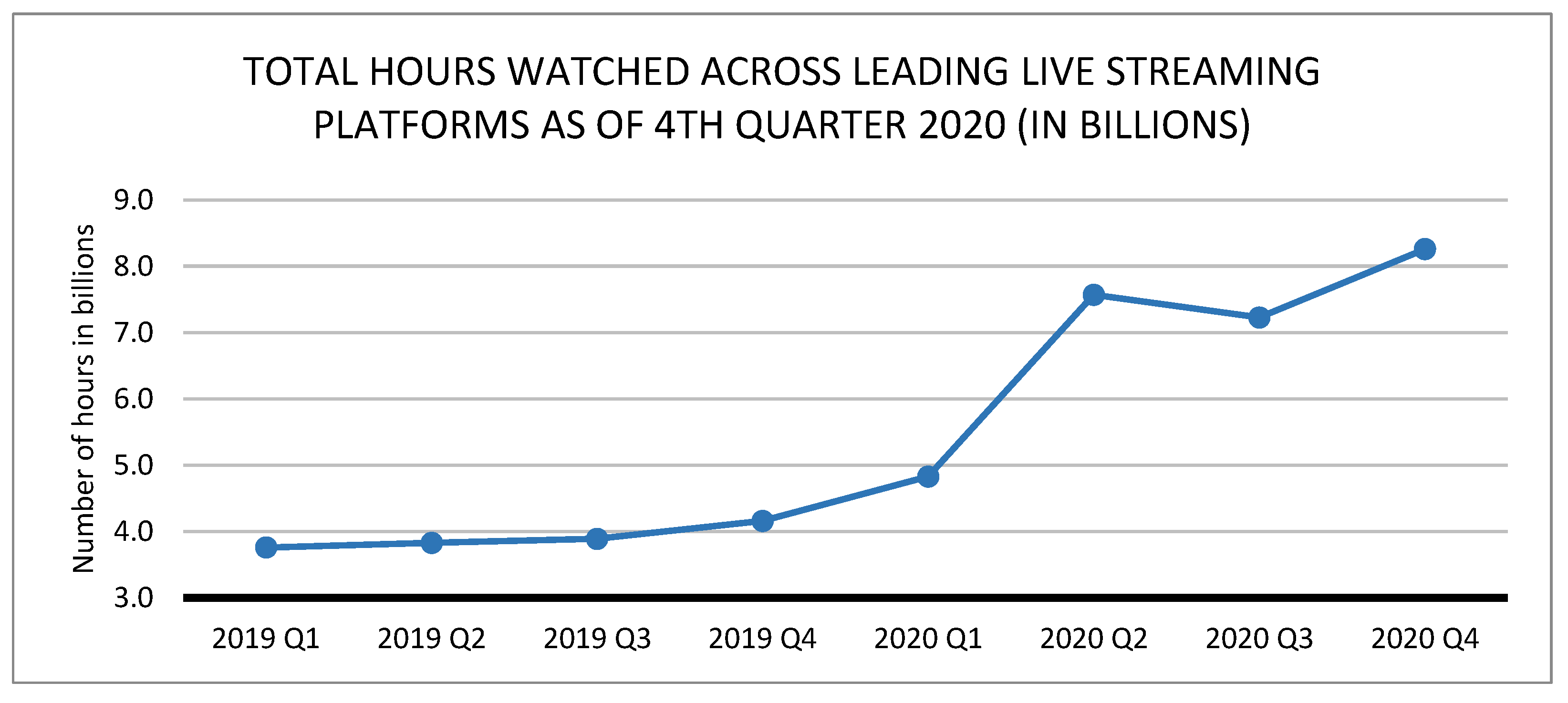
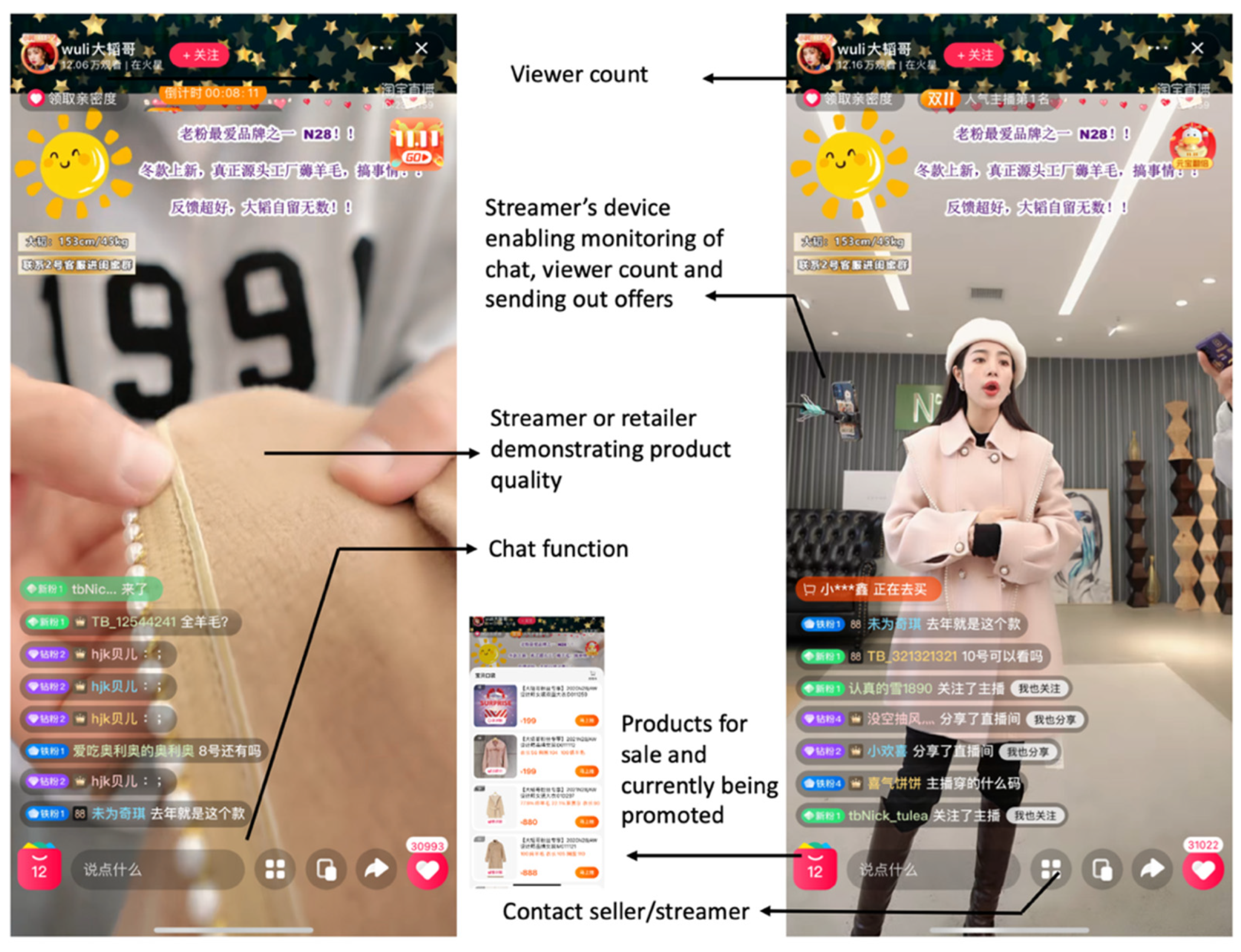






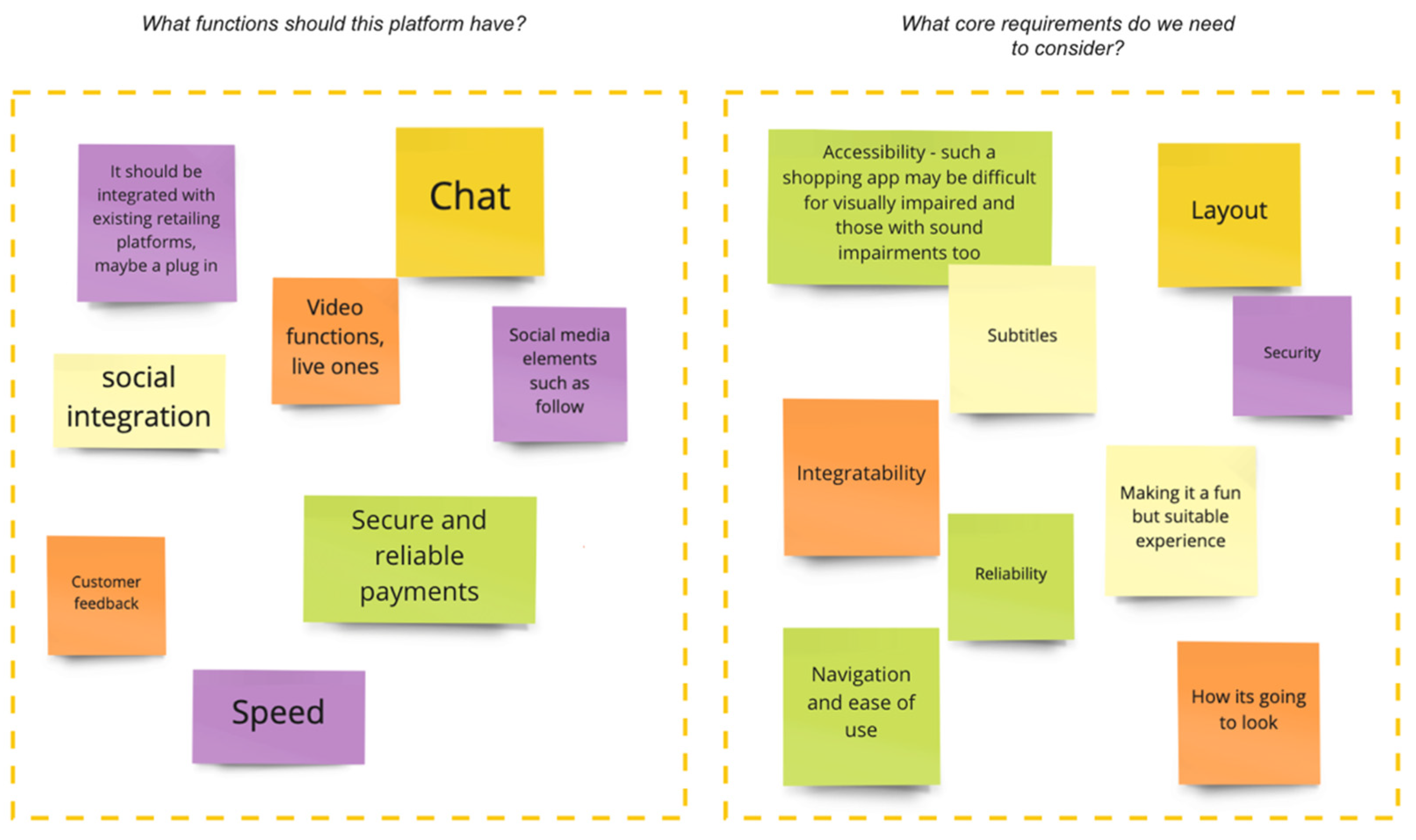
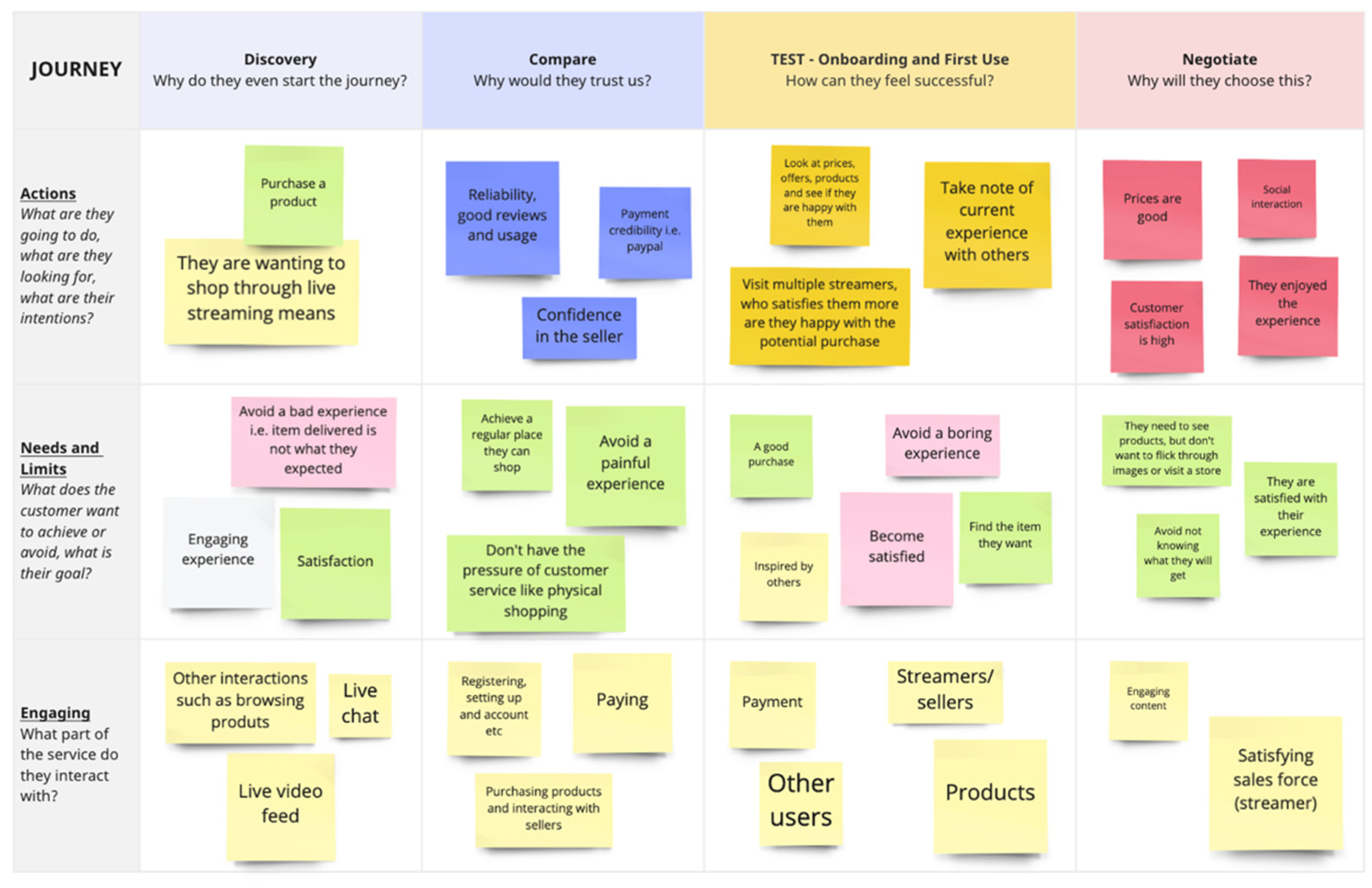




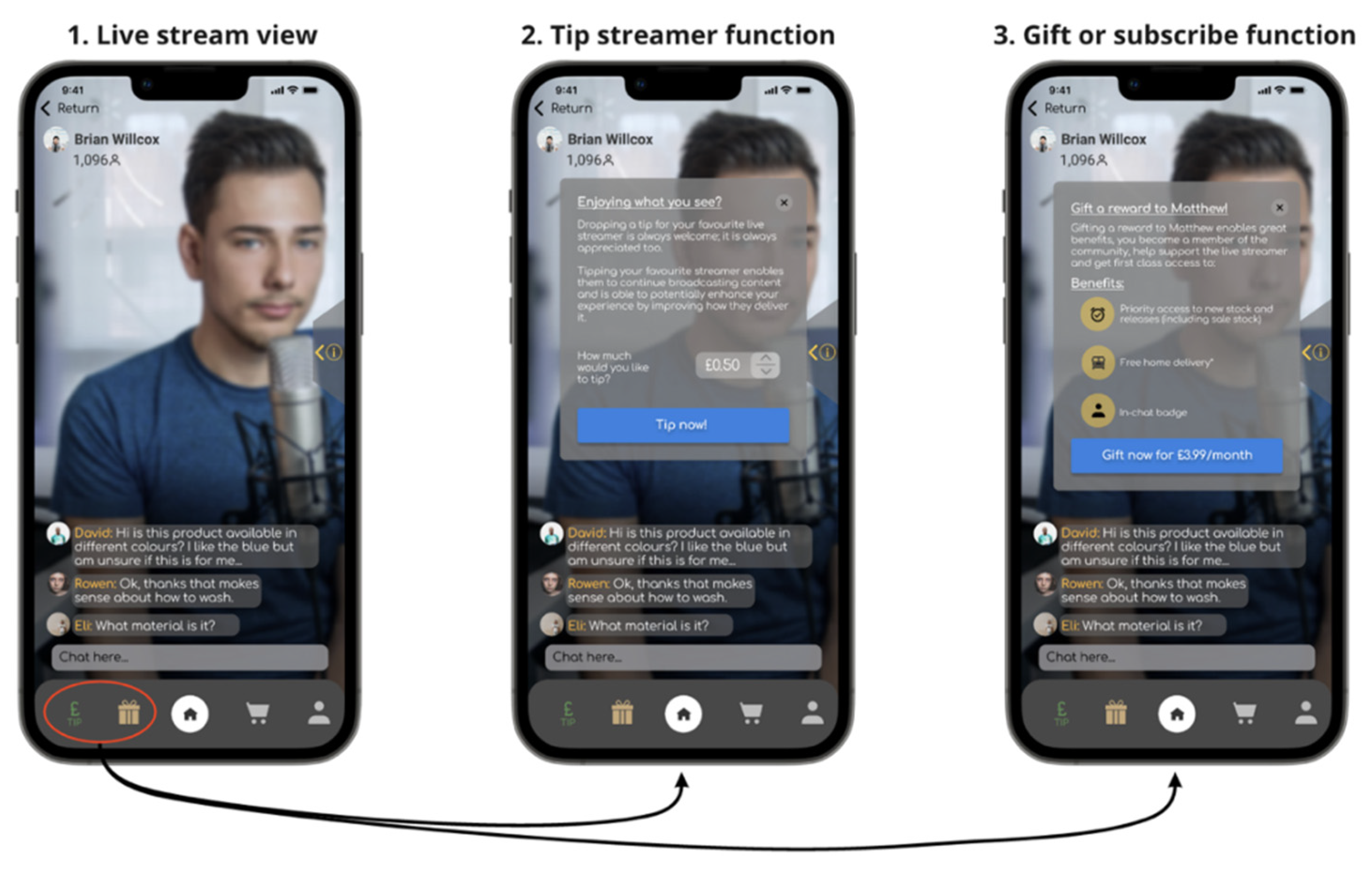
| Chat Functions | users can chat amongst each other, express their opinions and questions via chat functions in a live stream |
| Viewership | often associated with high user or customer interest, the more viewers the more customers and in turn more satisfaction |
| Followership | users can show their loyalty or interest in a streamer through following their channel, which will alert them when they next go live |
| Channel Subscription | users can show their loyalty and satisfaction to a streamer by paying a monthly/annual subscription, which also reaps user benefits |
| Monetary Donations | users are able to send monetary gifts or donations to their streamers, in Twitch these are known as ‘Bits’ |
| When Was the Last Time You Shopped through This Method? | |||||||
|---|---|---|---|---|---|---|---|
| Today | A Few Days Ago | Last Week | A Few Weeks Ago | A Month Ago | Over a Month Ago | ||
| What is your preferred shopping method? | High Street | 5 | 11 | 8 | 6 | 3 | 3 |
| Online | 9 | 14 | 11 | 14 | 1 | 2 | |
| Why Do You Prefer Shopping on the High Street or Physically? | |||||||
| Convenient | Enjoyable Experience | Interaction | Like to See Physical Items | Social Aspects of Shopping | Try before You Buy | ||
| Gender | Female | 1 | 3 | 2 | 5 | 7 | 3 |
| Male | 2 | 0 | 0 | 6 | 4 | 3 | |
| Why Do You Prefer Shopping Online? | |||||||
| Convenient | Easier | Enjoyable Experience | More Choice | Saves Time | |||
| Gender | Female | 6 | 2 | 3 | 4 | 11 | |
| Male | 11 | 0 | 4 | 5 | 5 | ||
| How Satisfied Were You with Your Last Shopping Experience? | ||||||
|---|---|---|---|---|---|---|
| Very Satisfied | Somewhat Satisfied | Neither Satisfied Nor Dissatisfied | Somewhat Dissatisfied | Very Dissatisfied | ||
| What is your preferred shopping method? | High Street | 13 | 11 | 4 | 6 | 2 |
| Online | 9 | 9 | 4 | 19 | 10 | |
| What Is Your Preferred Shopping Method? | |||
|---|---|---|---|
| High Street | Online | ||
| What made your experience satisfying? | Customer Service | 5 | 2 |
| Convenience | 4 | 9 | |
| Product range | 6 | 3 | |
| Enjoyable experience | 4 | 3 | |
| Interaction | 7 | 2 | |
| Accessibility | 2 | 2 | |
| What made your experience dissatisfying? | Customer Service | 3 | 10 |
| Inconvenience | 2 | 8 | |
| Product Range | 1 | 2 | |
| Unenjoyable experience | 2 | 4 | |
| Lack of interaction | 0 | 6 | |
| Accessibility | 0 | 0 | |
| Do You Know What Live Stream Retailing Is? | Have You Ever Experienced Live Stream Retailing? | ||||||
|---|---|---|---|---|---|---|---|
| Yes | No | Yes | No | ||||
| Age | 18–25 | Gender | Female | 5 | 24 | 5 | 24 |
| Male | 4 | 16 | 2 | 18 | |||
| 26–45 | Female | 6 | 0 | 2 | 4 | ||
| Male | 1 | 13 | 0 | 14 | |||
| 46–65 | Female | 1 | 5 | 0 | 6 | ||
| Male | 0 | 5 | 0 | 5 | |||
| 66 and over | Female | 0 | 6 | 0 | 6 | ||
| Male | 0 | 1 | 0 | 1 | |||
Publisher’s Note: MDPI stays neutral with regard to jurisdictional claims in published maps and institutional affiliations. |
© 2022 by the authors. Licensee MDPI, Basel, Switzerland. This article is an open access article distributed under the terms and conditions of the Creative Commons Attribution (CC BY) license (https://creativecommons.org/licenses/by/4.0/).
Share and Cite
Merritt, K.; Zhao, S. The Power of Live Stream Commerce: A Case Study of How Live Stream Commerce Can Be Utilised in the Traditional British Retailing Sector. J. Open Innov. Technol. Mark. Complex. 2022, 8, 71. https://doi.org/10.3390/joitmc8020071
Merritt K, Zhao S. The Power of Live Stream Commerce: A Case Study of How Live Stream Commerce Can Be Utilised in the Traditional British Retailing Sector. Journal of Open Innovation: Technology, Market, and Complexity. 2022; 8(2):71. https://doi.org/10.3390/joitmc8020071
Chicago/Turabian StyleMerritt, Kamarin, and Shichao Zhao. 2022. "The Power of Live Stream Commerce: A Case Study of How Live Stream Commerce Can Be Utilised in the Traditional British Retailing Sector" Journal of Open Innovation: Technology, Market, and Complexity 8, no. 2: 71. https://doi.org/10.3390/joitmc8020071
APA StyleMerritt, K., & Zhao, S. (2022). The Power of Live Stream Commerce: A Case Study of How Live Stream Commerce Can Be Utilised in the Traditional British Retailing Sector. Journal of Open Innovation: Technology, Market, and Complexity, 8(2), 71. https://doi.org/10.3390/joitmc8020071






